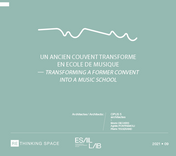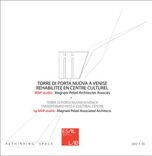Publications & Research
ESAIL LAB
Created in 2013, the ESAIL’s research department ESAIL LAB looks at operations conducted to renovate old buildings. These operations have given rise to discussion on interior architecture, a discipline taught at ESAIL. The objective of using this kind of empirical material as a starting point is twofold.
The first objective is to analyse the discipline and its practices by looking at projects completed in the not-so-distant past.
One must scrutinize a project in order to be able to explain it. The work involved is complex, and seeking to bring to light the intellectual processes of the discipline seems more than right. If lessons are to be drawn from good examples, we must take the time to dissect and better understand them.
First and foremost, it consists in attempting to explain all the work undertaken to bring a project to completion – by shedding light on a design process that was able to disentangle itself from various constraints, by bringing attention to agency documents that were not necessarily hitherto published, by obtaining explanations from project developers, by understanding their intentions – in order to achieve the highest level of understanding possible.
It also entails explaining completed architectural works, when ideas take form and when people live in, use, take ownership of and interpret spaces. Spaces that were once in the mind’s eye become a physical reality that engages the senses of those who them and who, conversely, experience this spatial reality.
The aim is thus to explain an architectural work both in terms of the “backstage” part (the design stage) as well as the “public” part (when a work is adopted by various publics).
The second objective seeks to contribute to a more general discussion on the possible theoretical tools of architectural renovation. ESAIL LAB focuses on this in a series of published case studies. Our ambition is to successively analyse multiple projects to form a more general analysis of spatial transformation processes.
A multi-purpose venue in Bordeaux

A multi-purpose venue in Bordeaux
"This work analyzes the transformation of a warehouse connected to a commercial space and housing for the people who operate the business. The building consists of a stone-built basement, topped by a two-story wooden structure and enclosed by walls.
The project is driven by a design process that deeply analyzes the existing structure without a predetermined spatial outcome. All new architectural elements are materialized in metal, which unifies the regenerative process of the space."
Two stores in Ho Chi Minh City

Two stores in Ho Chi Minh City
"These are two retail locations with uninspired architectural layouts. The design process cannot be rooted in the architecture itself; instead, it must find its direction in the imagination and identity of the brands being sold.
In the first example, the design suggests the world of a spaceship, creating a sense of disorientation within the surroundings. In the second example, the world of gaming defines the spatial journey with a playful theme. In both cases, the act of selling is immersed in human-centered themes."
TWO SURPRISING LOCATIONS IN GREECE TRANSFORMED INTO HOTELS K-Studio

TWO SURPRISING LOCATIONS IN GREECE TRANSFORMED INTO HOTELS K-Studio
“Each of these projects has its own historical material. An industrial site dating back to the end of the 19th century on the one hand; a cave house representing a centuries-old tradition on the other. Concrete tanks that need opening up and an austere site to be mellowed for the first; a vertiginous slope to tame, additional accommodation space to hang, whatever it takes, from the abrupt cliff-face for the second.”
TRANSFORMING A FORMER CONVENT INTO A MUSIC SCHOOL OPUS 5 architectes

TRANSFORMING A FORMER CONVENT INTO A MUSIC SCHOOL OPUS 5 architectes
“Originally, the cloister surrounded the water, as if aiming to extract a section of the waterway. A posteriori, we can imagine the joy of walking around this space. A space where walking around the river was an active form of meditation. A miniature version of the cloister keeps the exterior hubbub at bay, leaving only the sky and the water with which to engage a dialogue. From the outset, this choice of location is sensitive in terms of sound. The cloister formed two folded arms enveloping the river, to better hear its voice, an embrace in which its very essence was felt. But an unfortunate period of history destroyed this poetry! It is a curious coincidence that by chance the musical theme returned triumphantly to this site which is now entirely dedicated to it.”
MORA RAILWAY STATION TRANSFORED INTO A MUSEUM CVDB Arquitectos

MORA RAILWAY STATION TRANSFORED INTO A MUSEUM CVDB Arquitectos
“The strata theme nourishes several different levels of the project definition and contributes to creating a sense of unity across the operation. First of all, it is meaningful in terms of the identity of the program. It relates to geology, the historical depths buried beneath our feet. It is structured by piling on layers, giving a tangible form to the passage of time. The same is true of this gallery which captures the sun’s rays from all directions depending on the time of day or the season of the year, a spatial situation in which configurations resulting from the passage of time lead on one from another. Permanently ephemeral. Strata, light, shadows, these are the “natural” ingredients, carefully injected into the different parts of the project - both old and new.”
LIVING IN A CHURCH IN THE NETHERLANDS Etude de 4 édifices

LIVING IN A CHURCH IN THE NETHERLANDS Etude de 4 édifices
“Into this purely historical mix we also have to add the changes to the function of the building. The first gives the architectural space is lasting specificity. Living in a former church brings with it a notion of sanctifying the domestic space. An unconventional, somewhat intimidating volume, natural light filtered by the stained-glass windows, and specific acoustics, are all very present features once the project is completed. They give daily life a certain sacred status. The benefit obtained from mixing these two very different purposes. As well as the multiple layers of historical materials physically present, there are also existential dimensions in the same place.”
MONS MEMORIAL MUSEUM, FROM AN INDUSTRIAL BUILDING TO A MEMORIAL Atelier Pierre Hebbelinck

MONS MEMORIAL MUSEUM, FROM AN INDUSTRIAL BUILDING TO A MEMORIAL Atelier Pierre Hebbelinck
“These re-appropriations, substitutions, shifting meanings, give our building a new lease of life. Pierre Hebbelinck has imagined new ways of creating meaning within it. The space demonstrates this flexibility, this elasticity, this potential it has to regenerate. It no doubt also has the merit of having forced the designer to formulate new, or at least unexpected, spatial responses.”
TORRE DI PORTA NUOVA IN VENICE, TRANSFORMED INTO A CULTURAL CENTRE MAP studio

TORRE DI PORTA NUOVA IN VENICE, TRANSFORMED INTO A CULTURAL CENTRE MAP studio
“This staircase needs to compete with the other imposing architectural components in place. The strength of the solution is dependent on the choice of an appropriate structural mechanism.”
RENOVATION OF RURAL CONSTRUCTIONS IN THE SWISS CANTON OF THE VALAIS Savioz Fabrizzi

RENOVATION OF RURAL CONSTRUCTIONS IN THE SWISS CANTON OF THE VALAIS Savioz Fabrizzi
"These projects go beyond mere architectural considerations and root themselves in other values."
MATADERO MADRID, CREATING A CENTRE FOR CONTEMPORARY ARTISTIC CREATIONS

MATADERO MADRID, CREATING A CENTRE FOR CONTEMPORARY ARTISTIC CREATIONS
"It can even be seen as a genetic mutation of the architectural space. An unpredictable qualitative leap is made."
MUSEE CHAMPOLLION IN FIGEAC Moatti & Rivière

MUSEE CHAMPOLLION IN FIGEAC Moatti & Rivière
"I think for a solution to stand the test of time it needs to have many levels of meanings."
THE RESTAURANT OF THE OPERA GARNIER Odile Decq

THE RESTAURANT OF THE OPERA GARNIER Odile Decq
"Everything began with a set of building specifications from the Commission Nationale des Monuments Historiques…and this story ends with a totally unpredictable project.”